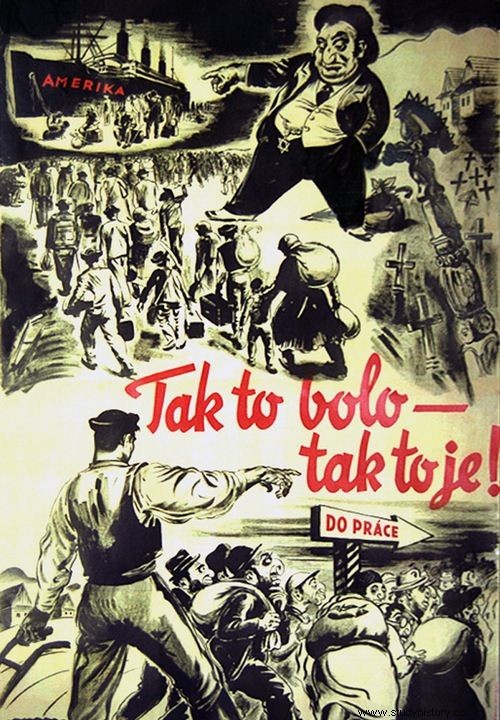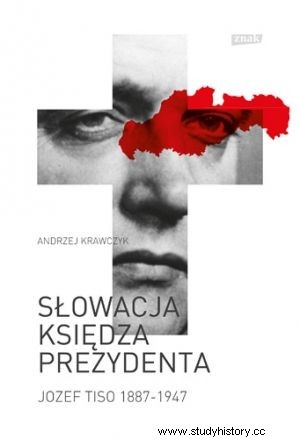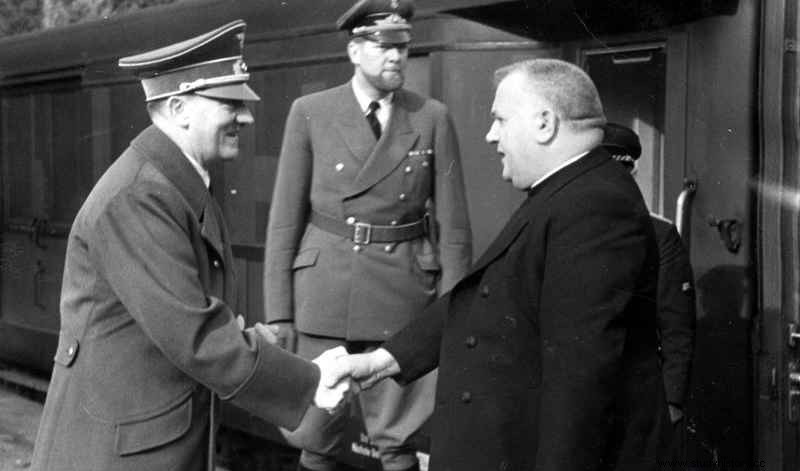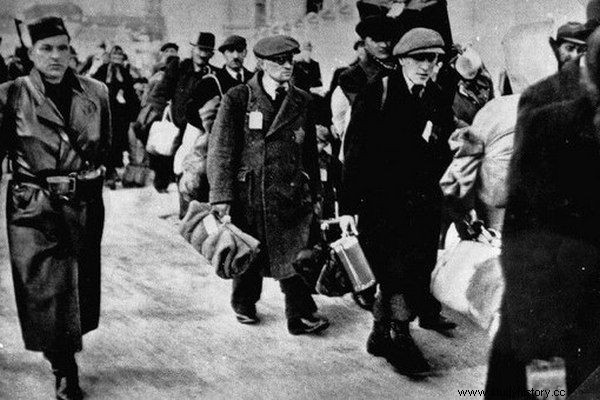Many countries collaborated with Hitler, putting a hand to exterminate their Jewish citizens. But only one country was ready to pay the Germans for every Jew that was gassed. It was Slovakia ruled by Father Tisa.
About 90,000 Jews lived in Slovakia in the interwar period. Until the fall of 1938, they did not have much to complain about. The authorities in Prague made sure that Jews were treated on an equal footing with other Czechoslovak citizens. The situation changed dramatically with the granting of autonomy to Slovaks, and then the declaration of Slovak independence.
Programmatic anti-Semitism
The new authorities, derived from the Slovak People's Party (ludacy), headed by Father Józef Tiso, did not hide their anti-Semitism. As Andrzej Krawczyk emphasizes in the recently published book, President of Slovakia: anti-Jewish decisions were among Tisa's first moves .
The occasion for this was the execution of the Vienna arbitration decisions of November 1938. Under it, Slovakia had to cede to Hungary a large part of its territory to the south and east. The Ludacy saw this as an opportunity to get rid of thousands of Jews. As Krawczyk writes:
Tiso and his colleagues came up with the idea of a rapid resettlement of Jews who did not have permanent residence in Czechoslovakia in the last hours of the Czechoslovak statehood.

It was with such posters that the Slovak authorities fueled anti-Semitism in society (source:public domain).
The local authorities were given an order to catch all the people so identified, and then to deport them to the areas handed over to Hungary. The key was that they did not manage to return to their current places of residence before the border was closed.
The operation - from Tisa's point of view - was almost completely successful. Seven and a half thousand people were deported in just over a dozen hours. But that was only the beginning of the ordeal that awaited the Slovak Jews.
Plunder Slovakia has never seen before
The following months saw an escalation of anti-Semitic policy. Almost simultaneously with the declaration of independence in Slovakia in March 1939, a large-scale action of "Aryization" of Jewish property was launched.
Pharmacies went first, then the Slovaks started dealing with Jewish enterprises, real estate and agricultural land. It got to the point that the Orthodox Jews were forbidden even to possess musical instruments!

The most famous photo of anti-Semitic propaganda on a wall of a building on one of Bratislava's streets. The photo and caption come from the book by Andrzej Krawczyk entitled "Slovakia priest president" (SIW Znak 2015).
In August 1941, the authorities also reached for savings collected by citizens of Jewish origin. As we can read in the book "Slovakia priest president":
from all Jewish bank deposits and savings accounts 50% of the deposited sums were taken and the newly created fund called the Fund for the Support of Jewish Emigration was transferred.
According to calculations by Slovak historians, it was 350 million crowns at that time. This is not the end, however. A few months later, the Jews were ordered to pay into special accounts any money they had in excess of the monthly standard living expenses .
Subsequently, all Jewish property was taxed at 20 percent. 20% of the previously collected sums were automatically seized for its repayment, which gave another 281 million kronor.
We did not have to wait long for the effects of such a policy. It is estimated that arization deprived more than 65,000 people of livelihood worth around 4.4 billion kronor . As a result, over 70% of the Jewish community found themselves in poverty.
The strictest anti-Jewish law in history
Of course, the harassment was aimed not only at property owned by Jews. The Slovak authorities also systematically restricted their civil liberties. The collaborator of the famous Adolf Eichmann Obersturmführer Dieter Wisliceny, who came to Bratislava in the summer of 1940, was to help. Its appearance resulted in a significant intensification of anti-Semitic activities.

Slovak Jews detained in the labor camp in Žilina (source:public domain).
On September 9, an ordinance on the legal situation of Jews was adopted. As Andrzej Krawczyk emphasizes in his work, the so-called "Jewish code":
was a comprehensive and stringent anti-Jewish piece of legislation in history . It was far superior in severity and was wider in scope than its German predecessor , that is the Nuremberg Laws.
This article has more than one page. Please select another one below to continue reading.Attention! You are not on the first page of the article. If you want to read from the beginning click here.
In the fall of that year, Jews were ordered to wear the yellow Star of David and special armbands on their clothes. There was also an idea to create ghettos. All this was in line with the beginning of the era of National Socialism in Slovakia, announced a few months earlier, one of the main assumptions of which was the complete "revival" of the country.

Another example of the anti-Semitic propaganda from the Slovak period of Father Tisa (source:public domain).
Bratislava will be a city "free of Jews"
Already in January 1941, the Slovak Prime Minister, Vojtech Tuka, threw up the slogan to deport Jews. This idea was unequivocally supported by President Jozef Tiso, who believed that Jews deserved severe punishment for "demoralizing" the Slovak nation. According to the author of the book "Slovakia Priest President":
In the second half of 1941, anti-Jewish policy entered a new phase. It ceased to concern only property matters. It began to extend to restrictions on participation in public life and the most basic freedom of movement.

The authorities began preparations for internal deportations aimed at making Bratislava a city "free of Jews". It was intended to achieve this thanks to the forced resettlement of thousands of people to the eastern parts of the country.
These plans, however, changed during the meeting of leading Slovak politicians with Adolf Hitler, which took place in October of the same year in Kętrzyn. It was then that Vojtech Tuka spoke for the first time with the head of the SS, Heinrich Himmler, about the deportation of Slovak Jews to German-occupied Poland. This discussion gave rise to a definitive "solution to the Jewish question" in Slovakia.
500 marks for a Jew
Already at the beginning of December, the Slovak prime minister signed an agreement with the German ambassador enabling the deportation of local Jews to the territory of the Third Reich. Two months later, Berlin asked Bratislava to send additional workers to work in German factories. The Slovaks saw an opportunity in this and stated that they could provide 20,000 "unproductive" Jews.
Over the next few weeks, talks concerning the logistics of the entire undertaking continued. In the end, the authorities in Bratislava agreed to pay the Germans 500 marks for each Jew sent to the General Government.
It was the so-called settlement fee (after crossing the border, Jews automatically lost their citizenship), that is, in fact, the amount for which the Slovaks were ready to get rid of the Jews without getting their hands dirty.

Meeting of Jozef Tisa and Adolf Hitler. October 1941 (source:public domain).
To this day, there are fierce disputes in Slovakia as to which side proposed the deportations and whether the Slovaks, headed by President Tisa, knew that the deported people would be murdered. However, it must be clearly stated here that even if Tiso was not aware of it, he would - as Andrzej Krawczyk rightly notices:
knew from reports of Slovak military (including chaplains) on the Eastern Front about mass executions and murders of Jews in Ukraine . It was obvious that the Jews deported to the General Government or to the front lines in Ukraine faced a terrible fate, that they would be treated cruelly and that the death rate among them would be great.
Slovak Holocaust
However, it did not matter to the clergyman in the slightest. The first transport left Poprad near the Tatra Mountains shortly before midnight on March 25, 1942. It counted 999 women who ended up in the Auschwitz camp. They were given numbers there from 1000 to 1999. This gave rise to the camp in Birkenau (Brzezińce).

Slovak Jews destined for deportation under the guard of the Hlinkowa Guard (source:public domain).
In total, in Operation David, which lasted until October 1942, 57,792 Slovak Jews were transported to German extermination camps in occupied Poland in 57 transports. Of these, almost 7,000 were children under the age of 10, who were gassed almost immediately after reaching the destination . Deportation - according to very divergent estimates - was avoided by a dozen or so to 35 thousand people.
Formally, a decision to stop the deportations has never been issued. However, until the fall of 1944, no new transport departed from Slovakia to the extermination camps. The situation changed after the outbreak of the Slovak National Uprising, when Hauptsturmführer Brunner went to Bratislava on Eichmann's personal order.
He carried out - with the active help of the Slovaks - a large-scale round-up of Jews. As a result, another 14,000 people were sent to Auschwitz. They shared the fate of their kin who had been murdered two years earlier. In total, more than 80% of Slovak Jews lost their lives during the reign of Jozef Tisa. It was the highest percentage among all countries collaborating with the Third Reich.
Sources
Basic
- Andrzej Krawczyk, Slovakia, the president's priest. (Jozef Tiso 1887-1947) , SIW Znak 2015.
Complementary
- Lucy Dawidowicz, The War Against the Jews, 1933-1945 , Bantam 1986.
- Martin Lacko, A two-armed cross in the shadow of a swastika. Slovak Republic 1939-1945 , Oficyna Wydawnicza El-Press s.c. 2012.
- Timothy Snyder, Black Earth. The Holocaust as a warning , Horizon 2015 sign.
